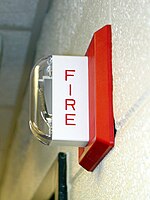
Photo from wikipedia
With rising temperatures and events contributing climate change, the world is facing extreme weather patterns. Recently, Australia was hit hard by bushfires, the most devastating fires ever faced by the… Click to show full abstract
With rising temperatures and events contributing climate change, the world is facing extreme weather patterns. Recently, Australia was hit hard by bushfires, the most devastating fires ever faced by the country. The economic damage reported was nearly one billion Australian dollars and an estimated 3 billion native animals killed or adversely affected. Given the extent and intensity of this damage, researchers are seeking effective solutions to enable the prediction of fire before it starts to increase the time available for firefighters to protect lives and assets and prepare to mitigate the fires. This motivated us to investigate an approach to address this critical problem. In this paper, we propose a Machine Learning (ML)–based approach that detects anomalies in spatiotemporal measurements of environmental parameters (e.g., temperature, relative humidity, etc.). In the proposed approach, an ML–based model learns the normal spatiotemporal behaviour of the environmental data (collected over a period of one year). This is carried out during a one-time training phase. Then, during the detection phase, any spatiotemporal pattern in the real–time data (received from the field sensors) that is different than the normal pattern will be identified by the model as anomaly which indicates a possible bushfire situation. Following this, we propose a supplementary classification model based on Moran’s I index to ensure that the detected anomalies are not due to either a sensor failure or a security attack (which are common in IoTs). We developed three different ML models for performance evaluation and comparison and used the Forest Fire dataset to train them. The results of our experiments confirm the effectiveness of the proposed approach in the early detection of fire symptoms.
Journal Title: IEEE Internet of Things Journal
Year Published: 2021
Link to full text (if available)
Share on Social Media: Sign Up to like & get
recommendations!